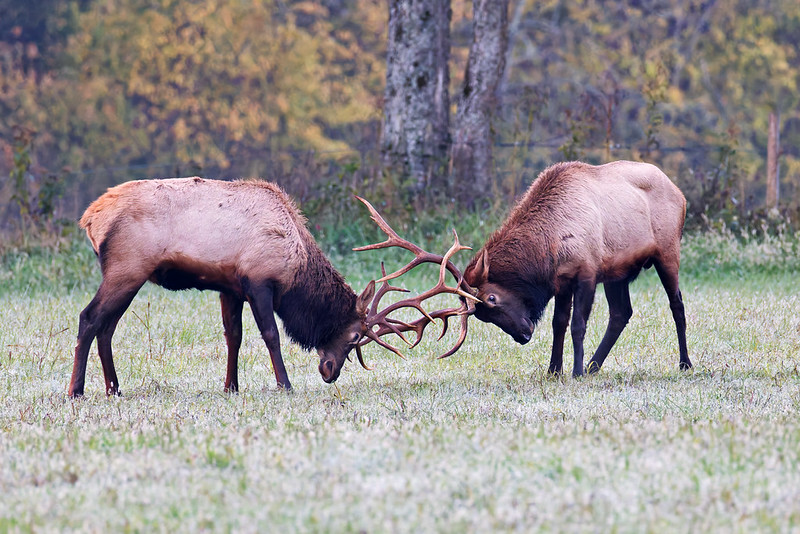Two mature bull elk lowered their heads in the fog. Their antlers met with a deep, solid sound. These were not the young bulls I wrote about yesterday. These were older, heavier animals.

Wildlife Notes
The bulls moved with deliberate precision. Each push carried more weight than the playful exchanges between younger bulls. The fog wrapped around them as they tested each other’s strength.
I photographed this encounter on November 3rd in Boxley Valley, part of the Buffalo National River in Arkansas. I had set up my tripod at the edge of the field near the road. The still air carried the sound of their antlers across the pasture.
Mature Bull Elk Sparring Behavior
Mature bulls approach sparring differently than younger animals. They conserve energy and choose matches carefully. The bulls I photographed were both large-bodied with thick antlers, survivors of several ruts who understood the cost of combat.
Their movements showed experience. They locked antlers, pushed steadily, then disengaged cleanly. No wasted motion, no erratic charges. Only measured force and careful positioning.
Older bulls establish dominance through reputation as much as strength. By early November, most have already claimed their rank. Sparring at this stage maintains that hierarchy more than it challenges it.
The encounter lasted about ten minutes. Neither bull gained a clear advantage. They separated, grazed briefly, then moved off together without injury or aggression.
This contrasted sharply with the young bulls I saw earlier that morning. Those animals moved with more enthusiasm and less control. The mature bulls needed none of that. They knew exactly what they were doing.
Observing Bull Elk of Different Ages
November 3rd gave me a rare chance to photograph both young and mature bulls in the same field. I arrived at sunrise and set up along the road for a stable vantage point.
All four bulls were in the field with several cows when I set up. The younger bulls sparred intermittently while feeding, their exchanges brief and energetic. I photographed them for about two hours before they moved toward the timber.
The mature bulls sparred later in the morning. The contrast was immediate and obvious. The young bulls stayed clear of the older ones, and the mature bulls ignored them completely. Each group followed its own rhythm.
The fog likely helped. Low visibility encouraged more bulls to use open ground, and the cool air kept them active longer than usual.
Why Mature Bull Elk Spar in November
The peak rut in Arkansas runs from late September through mid-October. By early November, most breeding has ended. Mature bulls lower their aggression but keep social order.
Sparring now reinforces dominance without high risk. Bulls can test rivals without injury before winter. A broken antler or leg in November could be fatal in freezing weather.
These encounters also let older bulls assess future rivals. They gauge which younger males might challenge them next season. The fog that morning may have triggered the interaction. Reduced visibility favors close-contact communication.
Differences Between Young and Mature Bull Elk Sparring
Young bulls spar frequently, often multiple times a day. They build strength and technique through repetition. Mature bulls spar less often but with more purpose. Each push carries meaning. When they are done, they disengage completely.
Young bulls chase and posture. Mature bulls do not. They spar, separate, and return to feeding. Their silence says more than noise could. Even the sound of their antlers differs. Young bulls make higher-pitched clicks, while mature ones create deep, resonant impacts audible across the valley.
For more on the younger bulls that morning, see Young Bull Elk Sparring in Boxley Valley.
Photography Notes
I used my Canon EOS R5 with the Canon RF 200–800mm F6.3–9 IS USM lens at 800mm. Settings were ƒ/9 at 1/640 second, ISO 8000. The fog cut the light, so I added +1/3 stop exposure compensation.
The high ISO was necessary to freeze movement. The R5 handles noise well, and I accepted that trade-off. My tripod kept the setup steady, and the fog acted as a natural diffuser, softening the light and reducing shadows.
Autofocus locked onto the nearest bull’s eye when visible, then switched to body tracking as they moved. The lens stayed quick even in fog. I remained stationary near the road, which kept the elk calm and predictable.
Finding Elk in Boxley Valley
Boxley Valley supports a healthy elk herd, reintroduced by the National Park Service in the 1980s. Bulls of all ages appear in the fields along Highway 43.
Fog is common here in fall and winter, especially near streams. It creates moody conditions but also interesting challenges for photography. Patience matters. I spent over two hours that morning, and the results were worth it.
Safety and Ethics in Elk Photography
I stayed by the road the entire time. The elk could see me and chose to tolerate my presence. I never entered the field or moved closer during sparring. Long lenses make that unnecessary.
Mature bull elk can weigh 700 pounds or more. Even light sparring can be dangerous. Keeping distance protects both photographer and elk. Staying still also reduces stress. Elk ignore stationary shapes but react to movement.
Closing Thoughts
November 3rd gave me one of the best elk encounters I have had in Boxley Valley. Watching both young and mature bulls in one morning revealed the full range of behavior. The older bulls showed control and experience that only come with age.
The fog added atmosphere and shaped the event itself. It is mornings like that which remind me why I return to Boxley Valley. The elk here still surprise me, even after years behind the lens.
Gear and Settings
Camera: Canon EOS R5
Lens: Canon RF 200–800mm F6.3–9 IS USM
Focal Length: 800mm
Aperture: ƒ/9
Shutter Speed: 1/640 second
ISO: 8000
Exposure Compensation: +1/3
